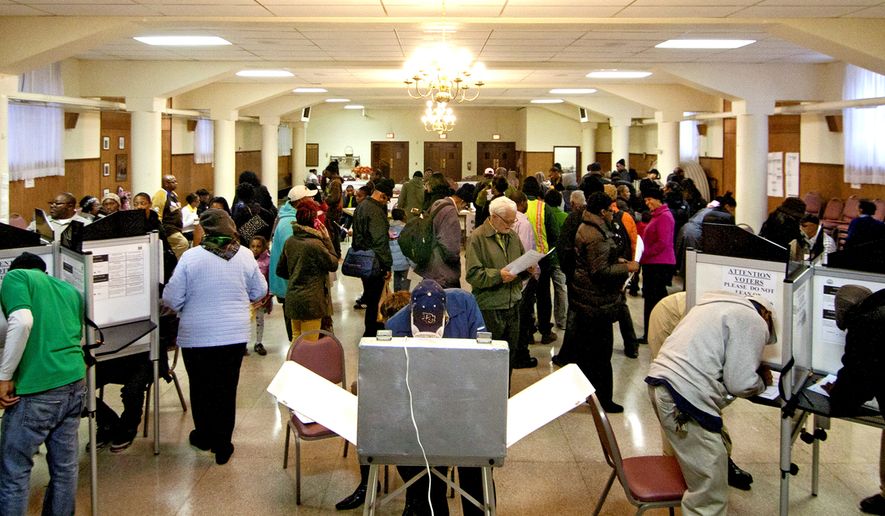OPINION:
Donald Trump, the Republican presidential nominee, is taking aim at the polls, saying they’re rigged as they’re sampling more Democrats to make it seem like he’s losing.
“When the polls are even, when they leave them alone and do them properly, I’m leading,” he said at a rally in St. Augustine, Florida, on Monday. “But you see these polls where they’re polling Democrats, ’How’s Trump doing?’ ’Oh, he’s down.’ They’re polling Democrats!”
On the same day, Mr. Trump tweeted, “Major story that the Dems are making up phony polls in order to suppress the Trump. We are going to WIN!”
Does Mr. Trump have a point? Well, yes.
If you look at the Washington Post/ABC poll released this week — giving Democrat Hillary Clinton a shocking 12-point advantage — the survey oversampled Democrats by 9 points over Republicans. It also under sampled independents compared to other polls. Independents have a tendency to break toward the challenger (Mr. Trump) after two years of the same party.
Democrats, in general, are given the edge in every poll because more Americans identify or lean toward the party. It’s the spread that makes it the most interesting. In the Investor Business Daily poll, which has Mr. Trump at a dead-heat with Mrs. Clinton or leading, it sampled 37 percent of Democrats, 29 percent of Republicans and 34 percent of independents.
The ABC/Washington Post poll sampled 36 percent of Democrats, 27 percent Republicans and 31 percent independents — shorting both Republicans and independents in their sample, compared to the IBD poll.
Perhaps the most interesting divergence between these two polls, however, is how they screen out likely voters. The IBD poll simply asks if an individual has plans to vote and if they answer yes, they’re included in the poll.
The ABC/Washington Post has a much tougher screening process. It employs “elements such as self-reported voter registration, intention to vote, attention to the race, past voting, age, respondents’ knowledge of their polling places and political party identification,” on whether an individual will be included in their poll.
Of the 1391 people ABC surveyed, only 874 were considered to be likely voters by the pollster. IBD surveyed 873 people and found 857 likely voters.
It’s easy to see how a Trump voter would be excluded from ABC’s survey.
Mr. Trump’s campaign — and many of the news reports detailing his typical supporter — describe them as being apolitical, with many voting for the first time, or the first time in years. They may not be playing close attention to the race, or know where their polling place is at the time of the survey.
Turnout is one of the hardest elements for pollsters to figure out. FiveThirtyEight’s Nate Silver gave four respected pollsters the same raw data of Florida voters, and based how they weighted it by political party or demographics, and determined likely voters, all four came out with different predictions — one with Mr. Trump leading by 1 point, another with him losing by 3.
So bottom line: Closely examine the polls coming out before Election Day and don’t let them sway your vote one way or the other. Much of the results reflect the pollsters own biases and sampling decisions.
Here are five examples were the pollsters got it wrong, weeks before the race, by underestimating Republican turnout and undersampling the party in their estimates.
1. Iowa Sen. Joni Earnest (2014). In an early October 2014 poll by the Des Moines Register, the poll had her essentially tied with Democrat Bruce Braley 47-46. It wasn’t even close on Election Day, with Mrs. Ernst defeating Mr. Braley by 8.5 percentage points, a margin outside even her strongest polling numbers.
2. Maryland Gov. Larry Hogan (2014). Polling aggregation site FiveThirtyEight gave Democrat Lt. Gov. Anthony Brown a 94 percent chance of winning his gubernatorial race against Republican Mr. Hogan (that’s higher than the 85 percent chance they’re giving Mrs. Clinton). Mr. Hogan won by 5 points, which was largely based on polls oversampling Democrats.
3. Kansas Sen. Pat Roberts (2014). On Oct. 20, a Monmouth University poll had Mr. Roberts, a Republican, tied with his independent challenger Greg Orman at 46 percentage points each. A few weeks earlier, an NBC/Marist poll had Mr. Orman up 10 points. Both polls underestimated Republican turnout. Mr. Roberts won the race by a 10 point margin — not even close.
4. Kentucky Gov. Matt Bevin (2014). Surveys conducted late in October showed Democrat Jack Conway with a healthy lead over his Republican rival, Mr. Bevin. That didn’t happen. Mr. Bevin won by nearly 8 points. The polls had underestimated Republican turnout and undecided voters overwhelmingly broke toward Mr. Bevin.
5. Virginia Sen. Mark Warner (2014). Polls showed Mr. Warner, a Democrat, winning the 2014 Senate race easily with 50 percent of the vote; Mr. Warner earned almost 50 percent but he barely won, eking by Republican challenger Ed Gillespie by the narrowest 0.8 percent point margin. The FiveThirtyEight model listed Mr. Gillespie’s chances at 0.5 percent. The pollster said a low Democratic turnout was responsible for the narrow victory, and some voters thought Mr. Warner was going to run away with the race (based on the polls), so they voted for Mr. Gillespie.




Please read our comment policy before commenting.